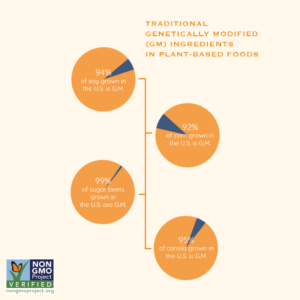Throughout September, we're celebrating the growing popularity of plant-based foods and the non-GMO innovation driving it. To help you keep GMOs out of your shopping cart, we're also shining a light on how genetic engineering shows up in this fast-growing food category.
Last week, we explored the rise of new GMOs in the plant-based space — you can read the blog here or explore this handy infographic.
In case you missed it, here's a quick refresher: New GMOs differ from traditional GMOs because they rely on emerging techniques such as CRISPR gene editing or synthetic biology. New GMOs can take many forms, including flavors, colorants, proteins, genetically engineered animals, etc. Traditional GMOs — sometimes described as "transgenic" because they combine genes from different taxonomic families — are made up of a handful of commodity crops engineered to withstand herbicide applications or to produce their own insecticide. Think soy, corn, canola and sugar beets. While the list of traditional, transgenic GMOs is relatively short, ingredients made from them are used in up to 75% of the products on grocery store shelves.
Traditional GMOs can show up in plant-based products, too. You can protect your right to choose by knowing what to look out for. When in doubt, look for the Butterfly!
Soy protein
Recipes calling for plant-based protein often use soybeans. Soy is a protein powerhouse in the plant-based world. It was also one of the first GMO crops in the United States.
Soy was the base ingredient for some of the first non-dairy milk alternatives. These days, soy milk shares shelf space with other popular plant-based milk products made from rice, oats, almonds and more. Soy is also the cornerstone of several meat alternatives, including tofu, tempeh and veggie burgers.
 Today, at least 94% of soy is genetically modified to withstand multiple applications of weedkillers, produce an insecticide, or both.
Today, at least 94% of soy is genetically modified to withstand multiple applications of weedkillers, produce an insecticide, or both.
A corn-ucopia of GMOs
More than 91 million acres of farmland are planted with corn in the United States. Most of that corn ends up in livestock feed or biofuel, while the remainder is processed for food manufacturing or used in industrial applications.
At the grocery store, corn and corn by-products are incredibly common. Corn can be the main ingredient, sweetener, starch, texturizer, or some other additive. A 2015 article in the Washington Post reported that corn is present in nearly every product in the grocery store. With 92% of corn genetically modified, the vast majority of those corn-derived starches, sweeteners and additives used on unverified products — or non-Non-GMO Project Verified products — come from GMOs.
Added oils and sweeteners
Oils and sugars are common in many processed foods, including plant-based options. Depending on what crops they're made from, they might be GMOs.
For example, canola oil is a widely available plant-based oil made from rapeseed. Canola oil is a common ingredient in prepared foods, including meat analogs and snacks, and some brands of vegan mayonnaise list canola oil as the first ingredient on the label. At least 95% of the rapeseed grown in the U.S. is genetically modified.
Sweeteners come in many forms. Genetically modified forms can include corn, which is processed into one of the most common sweeteners in food manufacturing — high-fructose corn syrup. Sugar also comes from sugar beets — and nearly all sugar beets grown in the States are genetically modified. GMO sugar cane is a recent development that's being cultivated in Brazil, and making its way through American regulatory systems. Sweeteners can appear in plant-based milk products, creamers, yogurts, processed foods and sweet products such as snacks and desserts.
At the Non-GMO Project, we often discuss new and traditional GMOs as two distinct categories determined by the technology that produced them. To be clear, both new and traditional techniques result in GMOs; they just go about it in unique ways which can impact their testing, labeling and regulation.
As the biotechnology industry continues its explosive expansion, we'll see more GMOs enter the market and more techniques developed to create them. And as our appetite for plant-based products continues to grow, our work protecting natural ingredients and non-GMO innovation in this space becomes more important than ever.
Stay tuned throughout September as we explore the products, ingredients and people driving the plant-based movement!
